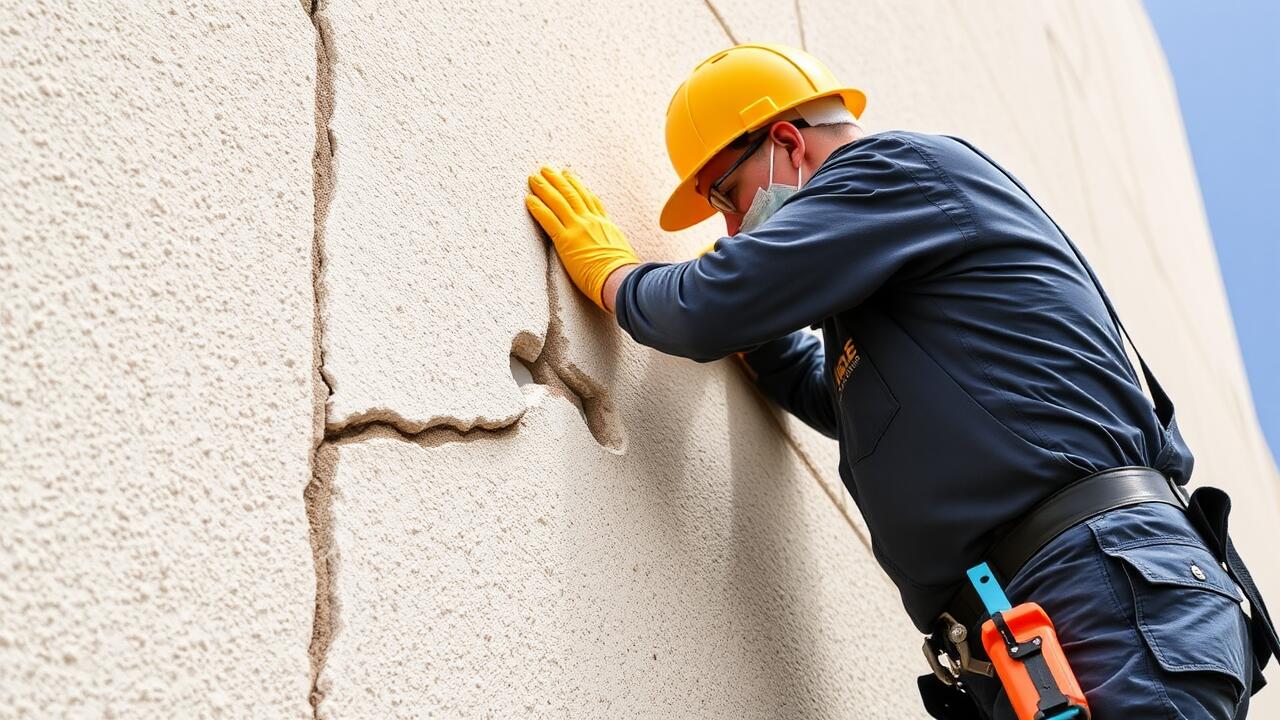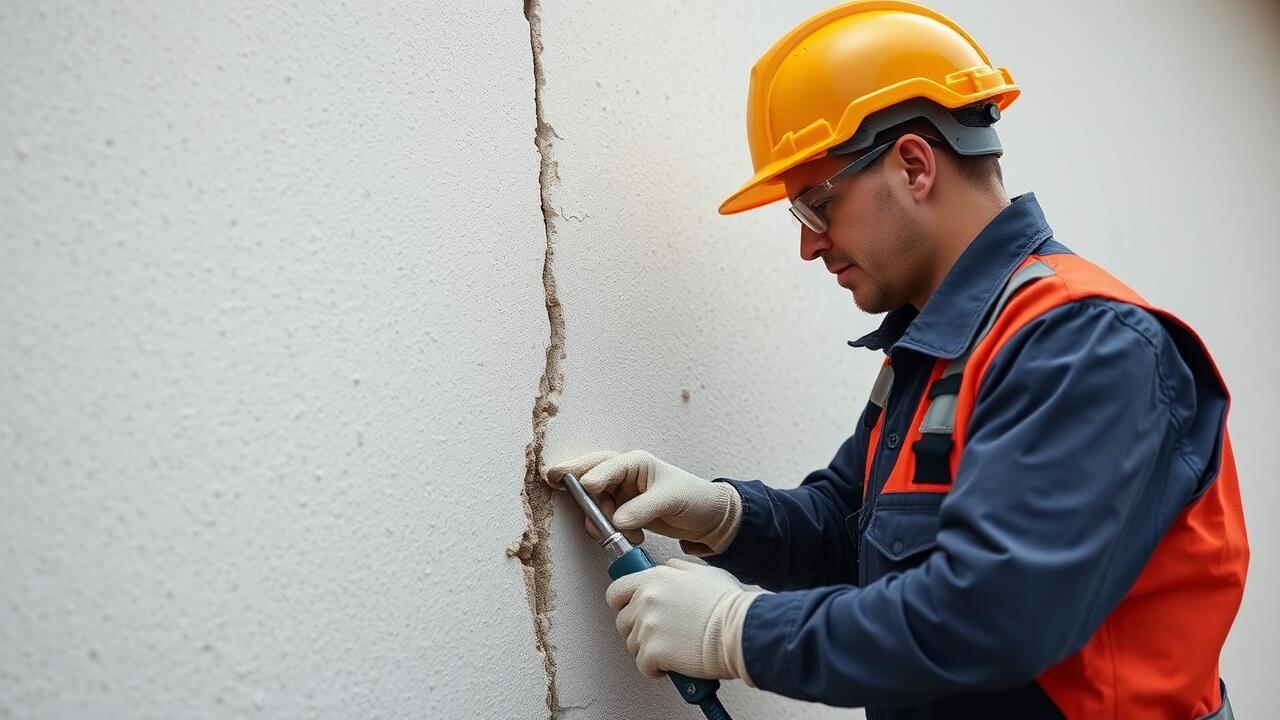
Repairing Larger Cracks
Larger stucco cracks require careful assessment before proceeding with repairs. Start by cleaning the crack thoroughly to remove any debris, dust, or loose material. A wire brush or a scraper can help in this process. After cleaning, it’s important to widen the crack slightly using a chisel. This allows for better adhesion of the patching material. Once widened, apply a bonding agent to promote a strong bond between the old stucco and the new repair material.
In areas like Boyle Heights, Los Angeles, where climate variations may affect the longevity of repairs, selecting the right materials is essential. Use a high-quality stucco repair compound designed for larger cracks. After filling the crack with the compound, smooth the surface using a trowel to achieve a seamless appearance. It’s beneficial to match the texture of the surrounding stucco for a cohesive look. Properly completing Stucco Crack Repair in Boyle Heights, Los Angeles, can significantly enhance the aesthetic and structural integrity of the building.
Techniques for Patching Significant Damages
Identifying the type and size of the crack is essential when undertaking stucco crack repair in Boyle Heights, Los Angeles. For larger cracks, clean the area thoroughly to remove any loose debris or broken pieces. A wire brush or a pressure washer can help with this task, ensuring a solid foundation for the repair material. After preparation, expand the crack slightly to create a V-shaped groove. This will allow the patching material to adhere better, improving the longevity of the repair.
Once the area is prepped, a patching compound specifically designed for stucco should be used. Apply the compound with a trowel, firmly pressing it into the crack. Feather the edges to blend the repair with the surrounding stucco. For added durability, consider reinforcing the patch with a mesh or fabric that matches the existing structure. This extra layer can provide additional support and minimize the risk of future cracking.
Applying New Stucco
When applying new stucco, it is essential to ensure that the surface is clean and free of debris. If the underlying structure has been previously painted, scraping away loose paint helps the new stucco adhere better. Mixing stucco involves combining Portland cement, sand, and water in the right proportions to achieve a workable consistency. This mixture should be applied in layers, starting with a scratch coat that creates a rough base for subsequent layers to bond to.
Once the scratch coat has cured, it's time to apply additional layers of stucco. Each layer should be applied while the previous one is still slightly damp, allowing for better adhesion between layers. Texturing the stucco can enhance its appearance and help it blend with the existing finish of your home. For residents considering rejuvenating their homes, seeking professional help for Stucco Crack Repair in Echo Park, Los Angeles, ensures that the job meets local standards and keeps your home looking its best.
Mixing and Applying Stucco for a Seamless Finish
Mixing stucco requires precise measurements to create a uniform consistency. Begin by combining the dry ingredients, often composed of Portland cement, sand, and lime, in a clean mixing container. Gradually add water while stirring continuously to avoid clumps. The ideal mixture should resemble creamy peanut butter. Make sure to mix only as much stucco as can be applied within a few hours to prevent it from hardening before use. For those considering professional help, companies providing services like Stucco Crack Repair in Boyle Heights, Los Angeles, can ensure the correct proportions and optimal results.
Application is equally critical for achieving a seamless finish. Utilize a hawk and trowel to apply the mixed stucco onto the repaired area, pressing firmly to ensure proper adhesion. Work in sections and feather the edges to blend with the surrounding stucco. Aim for an even texture to maintain the original appearance of the wall. Consider using a sponge float to create the final finish, which will help match the surrounding surface. Allow the newly applied stucco to set slightly before proceeding with any texturing techniques, thereby ensuring a cohesive look.
Ensuring Proper Curing
Curing new stucco is essential for achieving a durable and long-lasting finish. After applying the stucco mix, it’s important to keep the surface damp for several days. This hydration process helps to strengthen the mortar and prevent cracking. Mist the surface lightly with water several times a day, especially during hot or windy conditions, to maintain the necessary moisture levels.
In areas such as Boyle Heights, Los Angeles, where climate can vary, local environmental conditions may affect the curing time. It's wise to monitor the stucco for dryness and adjust the moisture application as needed. Protecting the freshly applied stucco from direct sunlight and strong winds will also contribute to a more adequate curing process. Implementing these practices during the curing phase can significantly enhance the results of your stucco projects, particularly for those focused on stucco crack repair in Boyle Heights, Los Angeles.
Best Practices for Curing New Stucco
Curing new stucco is essential for achieving a durable and long-lasting finish. After application, the stucco should be kept moist to prevent it from drying too quickly. This can be done by misting the surface lightly with water several times a day for at least a week. Avoid allowing the stucco to dry out too fast, as this can lead to unwanted cracks and shrinkage. Proper moisture retention aids in the curing process, ensuring that the stucco reaches its optimal strength.
In addition to maintaining moisture, the surrounding environment plays a crucial role in the curing process. Factors such as temperature and humidity can impact how quickly the stucco dries. During hot or windy days, it is even more critical to keep the surface moist. For homeowners seeking professional assistance, companies specializing in stucco applications, like those offering services for Stucco Crack Repair in Boyle Heights, Los Angeles, can provide guidance and ensure that the curing process is handled properly. Their expertise can make a significant difference in the overall quality and durability of the finished product.
FAQS
What are the common causes of stucco cracks?
Common causes of stucco cracks include settling of the foundation, temperature fluctuations, moisture infiltration, and improper installation or mixing of materials.
How can I identify if a stucco crack is serious?
Serious cracks are typically wider than 1/8 inch, show signs of water damage, or extend vertically or diagonally. If you notice these symptoms, it may require professional assessment.
Can I repair stucco cracks myself?
Yes, many small to moderate stucco cracks can be repaired by homeowners using the appropriate patching materials and techniques. However, larger or more complex issues may require professional help.
How long does it take for new stucco to cure?
New stucco typically takes about 28 days to fully cure, but initial drying may occur within a few days. Proper curing practices, such as keeping it moist, can help ensure a strong finish.
Is it necessary to repaint stucco after repairing cracks?
While it’s not always necessary, repainting can help blend the repaired areas with the surrounding stucco and protect the surface from future damage. It's advisable to use paint specifically designed for stucco.
